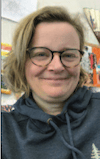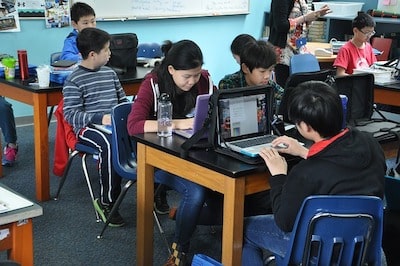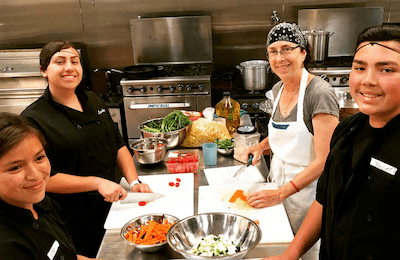Observing a Digital Day: Behind the Desk

By Lisa Catterall
I never teach my pupils, I only attempt to provide the conditions in which they can learn.
Albert Einstein
Recently my family was snowed in at a lodge in Tahoe. The roads were closed, and the news declared that students in their district would not take a snow day, they would observe a “Digital Day.”
Any time I use something with an electronic screen in my classroom, the students practically wriggle with joy.

It’s like they have been wrapped in a warm blanket, plopped on the couch with a cup of hot chocolate, and given a foot rub. It’s an audible sigh of psychic relief; Finally, We Are Comfortable!
In fact, this year, I’ve discovered so many new features on the web that I believe I could probably carry off a “digital day” in my classes. The kids might learn more of the curriculum from the syllabus than they can when they are in a room full of their friends. Isn’t that supposed to be my goal, delivery of the content on the syllabus, as approved by the school and the district and the state?
Our school was conceived of by a woman who wrote her Ph.D. on some- thing she called the “implicit curriculum.” That’s the framework schools provide so that students can learn to operate in a community together. It includes the golden rule, honoring differences, self-discipline, reaching goals, picking up after yourself, and, hopefully, personal growth.
One day in the summer, I visited campus, and a group offering personal growth retreats had rented out our assembly room. There was a large sign at the turnaround in front of the school which read “Speaking from the Heart. Room A3.”
Why isn’t THAT on our kids’ schedules? If a typical eleventh grader, one year from graduating to adulthood, is taking “Calculus, AP Literature, Spanish 3, American History, Physics, and Theatre,” could they not take “Logical Thinking, Looking Deeply, Honoring Differences, Knowing your Place in the Span of Humanity, Getting Comfortable with Complexity, and Expressing Yourself in Your Community” instead?
Wait. THEY ARE! I just renamed the classes.
I’m not certain, however, that the second list of course titles could accurately name classes taught mostly through digital days.
This morning, two students burst into my classroom early, having a high pitch conversation about being just “SO DONE” with high school. That turned into a conversation with me about what it feels like to face a big life transition. Earlier, as we were learning about how cancer drugs are made, students shared their personal stories about cancer with one another. Conversations, and human faces with nothing but air between them, take us places beyond the curriculum, all the time, every day.
Even teaching something from the content, something totally dry, is difficult for me to picture without seeing a student’s face. I completed a masters’ degree entirely online, and I learned an enormous amount about myself, my fellow students, and the world. But I still cannot imagine what it might be like to teach an eighth grader how to do algebra without watching their face comprehend each little idea, or seeing the order in which they write numbers down on a page.
Can I Skype teach then? I’d see the face, see the work going on…
No. Eleven years ago I went to see a mentor teacher of mine, and found her standing in the middle of a playground with an intense look of focus on her face. I started to ask her a practical question and she immediately silenced me. “Sssshhh. We are learning the everyday pitch and tone of the kids’ voices so we will know right away when something goes wrong.” I looked around and all the teachers were doing the same thing. Listening. Sensing. Using intuition. Feeling the vibe. Yes, I went there. The VIBE. Me, a quantitative and methodical math teacher.
I can’t say there is not learning magic in technology. To be able to bring TED Talks into my classroom in the blink of an eye, or use an online discussion board to elicit deeper critical thinking, is a gift from the pixel universe. I’m glad that those billions of bits of information are floating in the air around us, ready to be summoned at the touch of a key- stroke. I think my single favorite use of tech in the classroom is the giant panda cam, streaming pandas going about their day at the San Diego Zoo in real time. Their charisma draws out many an interesting conversation and story and piques curiosity about biology, geography, environmental science, and other topics.
But “digital days?” Only during winter storms, please.
Lisa Catterall teaches STEAM, math, science, and art at Mount Madonna School. She has authored curriculum frameworks for California and Kentucky on arts education as a senior associate of the Centers for Research on Creativity. She is a former Middle School Director and the founder of a STEAM engineering program. She lectures and trains teachers and administrators on innovation in education in Chaoyang District’s foreign experts program in Beijing, China. After spending 14 years in biotechnology, she began her teaching career as a middle school math teacher in her mid-thirties. Lisa has five children and has lived in Santa Cruz County for most of her life.





